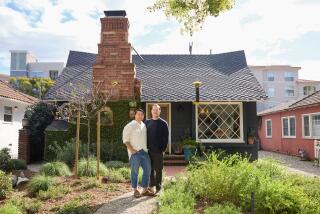Blocking With Bamboo
- Share via
It’s every homeowners’ nightmare--the modest house next door becomes a two-story, lot-filling monster after an ambitious remodel. Or a three-story apartment suddenly springs up where that little bungalow used to be--every one of its windows looking down into your backyard.
Quickly now, what do you do? Sell? Remodel? Or plant bamboo?
A number of homeowners have opted for bamboo--and not a diaphanous screen of the little 10-foot-tall stuff, but a solid wall of 50-foot-high timber bamboo, planted as a linear, lot-defining forest.
Overkill? A little, because many homeowners have to then top the bamboo at a more manageable 20 or 30 feet, but it sure does the job.
Giant timber bamboo encircles the garden of Cynthia Wick and her screenwriter husband, Channing Gibson, and it’s impossible to guess what lies beyond this leafy wall. Their Santa Monica garden is so private and so quiet that one is unaware there’s a busy world beyond. Wick says that the bamboo does not actually block sounds, but the gentle rustling of the leaves seem to mask many urban squeaks and rattles. It certainly blocks any views of neighboring properties and even helps disguise the conspicuous power pole at the rear of the lot.
Inside this private space, landscape architect Pamela Burton planted a garden on several levels that includes a “bird nest” of woven branches high in the bamboo for the two Gibson children to play in, and a magical “secret” path that snakes though the bamboo canes on its way to a sandbox. Timber bamboo might as well be giant sequoias, as far as children are concerned.
In nearby Mar Vista, landscape architect Katherine Spitz has been living with timber bamboo since 1986 and thinks it’s “fabulous.” It screens out everything--even the two-story apartment behind her--and it is still growing in a neat, hedge-like row that is less that 30 inches wide. She admits, however, that the extensive root system makes it difficult to garden within about 20 feet of the bamboo. She still manages to have a very lovely and architectural garden that is brimming with plants.
She does almost nothing for the bamboo--she hardly even waters it--but the Los Angeles Department of Water and Power tops the grove at about 40 feet to keep it out of the power lines. According to Randall Williams at Southern California Edison, bamboo is second only to palm trees as the utility’s least favorite plant because it must be cut back so often. He strongly suggests “not planting the big ones under power lines.” Timber bamboo quickly shoots up and gets between the power lines, causing them to slap together in winds, which he says can short out power in the neighborhood.
Even though giant timber bamboo may grow taller than need be, it is often planted simply because it’s available to landscape professionals in large sizes, often in full-grown clumps in big, 24-inch-square wooden boxes. When a three-story remodel suddenly sprung up next to avid gardener Ruth Borun’s Brentwood home, she needed privacy for her garden “right away” and had a contractor order 12 of these 24-inch boxes of timber bamboo, planting the clumps of bamboo so they almost touched!
“I’ve been carefully planting things for the last 30 years so the garden would be peaceful and private, and in a few months the privacy was gone. All I could see was the three-story white remodel towering over the garden,” she said. What did 12 24-inch boxes cost? “My husband won’t need to buy me birthday presents for a very long time,” she replied, “but I’m 74 and didn’t want to wait another 30 years.”
Certain bamboos can only be grown from divisions, so they are often hard to find (see box) and usually expensive. They are seldom found in anything smaller than a 5-gallon nursery can, which might cost $50. Timber bamboos in 24-inch boxes can cost $350 a pop.
Bambusa oldhamii, the botanical name for giant timber bamboo, “is good, but it really doesn’t make the best screen,” says Timothy Phillips, director of horticulture at Quail Botanical Gardens in northern San Diego County. It may not have any leaves or side branches at eye level or near the ground. Indeed, most are planted in front of 8-foot-tall fences. He nominates the scarce painted bamboo, Bambusa vulgaris ‘Vittata’ as his favorite tall bamboo. It grows to 30 feet and is very upright, with golden culms (what bamboo stems are called) that are streaked with what look like drips of green paint.
Another recommended tall bamboo is Bambusa membranacea, which can get to 60 feet in the right situation. It makes loose clumps of culms that grow straight as arrows. Still another big one--but with purple-black canes--is the Timor bamboo, Bambusa lako, which grows reasonably straight to 30 or even 60 feet tall.
If these timber bamboos sound too big for your yard, Phillips suggests the various Bambusa multiplex for shorter screens. These are commonly called hedge bamboos, and they typically grow to 25 feet, still tall enough to make a good screen. There are several decorative kinds, including one named ‘Alphonse Karr’ that has bright golden yellow canes with green vertical strips, and another named ‘Silverstripe’ that has some white-striped leaves and culms.
Phillips says some bamboos are prettier as stand-alone accent plants because they fountain so gracefully. Others, such as Chimonobambusa marmorea--the marbled bamboo--and some kinds of Phyllostachys can even be sheared into hedges.
George Shor, editor of the American Bamboo Society’s newsletter, says his favorite for screening is the weaver’s bamboo, Bambusa textilis, so-called because fibers from the thin-walled culms are used for weaving mats in Asia. It makes very tight clumps of culms that grow nice and straight to a height of 40 feet. “It’s great in tight places,” he said. The punting pole bamboo, Bambusa tuloides, is a straight, tall bamboo, growing to 50 feet, that makes extra-dense clumps.
For shorter bamboos, he also suggests the hedge bamboos, including Bambusa multiplex ‘Golden Goddess’ and ‘Fernleaf,’ which top out at 10 feet. Even though they gracefully arch outward, he says they makes good screens. The hedge bamboos are usually available at nurseries.
All of the bamboos just suggested are clumping kinds that more or less stay in one spot, not the running kind that sometimes spread great distances. Horror stories about bamboo running amok have given all bamboos an undeserved bad reputation.
The very pretty black bamboo is a runner and needs either a lot of room or some kind of containment. Common golden bamboo (Phyllostachys aurea) is another yard-eater. It is said you can control runners with a buried, sloping barrier that forces the creeping rhizomes up and over so they can be spotted and lopped off. Nothing will automatically contain them.
With clumping bamboos, you’ll have no such worries, but they are not maintenance-free. The inner culms in old clumps begin to die out in time and must be pruned out to make room for new, vigorous shoots. Some clumps can get so thick that it’s nearly impossible to cut out the old culms, so bamboo fanciers use electric, high-powered reciprocating saws such as the Sawzall to get between the dense culms.
Bamboos are really big grasses, and like lawns, they love water and fertilizer. Give them both to grow; withhold both to slow them down. They also need the mineral silica, used to make those sturdy canes. If you leave the natural leaf litter as a mulch, the silica will be recycled and the bamboo will have enough. But cart the litter away and you will need to add silica.
The leaf litter is actually quite decorative and--once clumps settle in--new shoots will burst through it with amazing speed. You’ll have a grove in no time.
*
Write to Robert Smaus, SoCal Living, Los Angeles Times, 202 W. 1st St., Los Angeles, CA 90012; fax to (213) 237-4712; or e-mail [email protected].
(BEGIN TEXT OF INFOBOX / INFOGRAPHIC)
Seriously Seeking Bamboo
There are hundreds of interesting kinds of bamboo, and many can be seen at Quail Botanical Gardens in Encinitas. It is the ultimate place to learn about bamboo and see particular kinds. This is where the American Bamboo Society maintains its display garden.
Twice a year (in April and September), Quail also hosts the Society’s bamboo sales. Unusual bamboos can be hard to find at regular nurseries.
For a list of 300-plus bamboos and some specialty nurseries that carry them, send a dollar bill (for postage) to the American Bamboo Society, 2655 Ellentown Road, La Jolla, CA 92037, and ask for its 32-page “Source List.” Its Web site with membership and cultural information is https://www.bamboo.org/abs.






